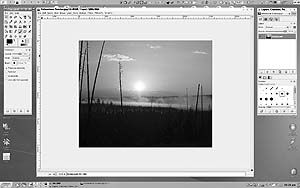| The GIMP’s multi-window layout is evident on an openSUSE Linux desktop. A future release may include an option to run the program in a single window environment like Adobe Photoshop or Corel Paint Shop Pro. |
It’s high time computer users and digital photography enthusiasts meet the GIMP.
No, this is not a person with a limp in their step. The GIMP – in this context anyway – is an open-source graphics editing program.
The GIMP, which stands for “GNU Image Manipulation Program,” is arguably the most advanced open-source graphics editor ever created.
Because the GIMP is open-source software, it is freely available to anyone who wants it. As one person described open-source is “free as in freedom, not free as in beer.” Like other open-source applications, the GIMP is built around an ideology that fosters sharing, cooperation and product quality.
One of the best things about the GIMP is that it is multi-platform. This means that it is available for more than one platform, or operating system. For example, the GIMP can run on Windows, Linux and even Mac OS-X (using X11).
The GIMP isn’t new. In fact, it’s been around since 1995. For end users, this means the GIMP has had time to mature into a stable, full-featured program.
The GIMP has virtually all the tools basic users need, from paint brushes, text tools and erasers to color picker (eyedropper) and canvas selection (marquee, magic wand) tools. It also has features that should please advanced users, like layers, paths, channel controls and effect filters.
The GIMP even has a nice angle and distance measuring tool.
But even though the GIMP is a very capable program, it takes an unorthodox approach to many tasks, and as a result, can be a little difficult for many computer users to get used to.
For example, the GIMP uses multiple, completely independent windows instead of a single window. For example, the program’s main tools (paint brush, fill tool, lasso, etc.) are in it’s own window, each open document is it’s own window, and layers, brushes and colors are in another individual window. It’s as if each window, or piece, is a different program. To fully minimize the program, one must minimize each piece individually.
This unique use of independent windows has been the center of much debate over the past several years and there has been talk among developers of providing an option that would make the GIMP operate within a single window, much like other popular graphics programs, like Adobe Photoshop. Unfortunately, given the GIMP’s slow development pace, it isn’t likely to happen any time soon.
Another highly unorthodox approach is it’s keyboard commands, which do not always follow the tradition of other major graphics editors. For example, to delete a selection, users must press Ctrl+K instead of simply pressing Delete. The lack of uniformity with keyboard commands can make it hard for many Windows users to adjust.
For Windows users, there are a couple extra caveats. Because the GIMP is designed primarily to run on the GNOME desktop environment on open platforms like Linux and BSD, the Windows version doesn’t behave or operate like a normal Windows program.
For example, the GIMP uses GNOME-like windows (“open”, “save as” boxes, etc.), even when it is running on other platforms, or operating systems. This can introduce some confusion for some less computer-savvy users.
Because the GIMP doesn’t fully support CMYK images, many professionals in the printing industry (newspapers, magazines) aren’t able to adopt it.
Still, the GIMP is very usable for basic and advanced users alike, especially for home users or amateur photographers.
It’s a very powerful program that competes with some of the bigger, expensive alternatives, especially for the cost – it’s hard to ignore ‘FREE’. And it can do wonders for digital photographers who like to touch up their photos to make them perfect.
The GIMP does require GTK libraries on Windows, which is included in the automated installer. It can be obtained by visiting www.gimp.org and clicking on the “GIMP for Windows” link. While there, Windows users should consider downloading the documentation. A download link is located further down the “GIMP for Windows” download page.
As most Linux distributions include the GIMP on the provided CDs, Linux users should install the GIMP from the distribution’s CD or DVD installation discs. OpenSUSE Linux users can install the GIMP via the “Software Management” tool inside the YaST2 control panel.
Regardless of the type of computer system the GIMP is installed on, the user will be presented with a first-time setup wizard when the GIMP is first run (on a per user basis). In most cases, users should simply leave default values in place and simply click the “next” or “continue” buttons until the wizard completes. At that point, the GIMP should start.
Learning the GIMP can be a little challenging, but once it is understood, it can be a very rewarding piece of software that can do wonders with your photos and other graphic files.
Have comments about this article or suggestions for a future Tech Tips article? Send an e-mail to webmaster@sunad.com.

